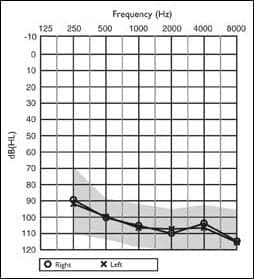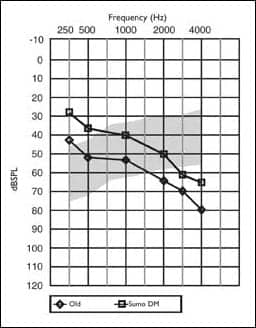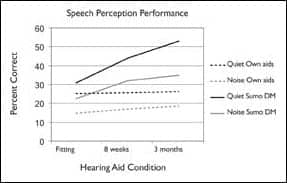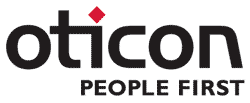This study examines the performance of 12 school-aged children with profound hearing loss following an upgrade to an advanced multiple channel non-linear hearing instrument. The design of the study was intended to overcome the concern raised in previous studies where there was difficulty in separating the improvement from the child’s normal development versus the improved audibility provided by the test hearing aids.
Unique to this study was the utilization of an A-B-A design in which the child’s old hearing aids were refitted at the end of the study so that direct comparisons could be made. Significant improvements were found in terms of audibility, speech understanding in quiet and noise, and subjective reports by the children and parents of performance in specific listening situations.
Importantly, the study indicated that performance with the old hearing aids remained stable, while performance with the test instrument (Oticon Sumo DM) continued to improve. This indicates that the gains made in the current study were solely due to the new hearing aids and not due to the child’s natural development. This study builds on the increasing evidence that children with a profound hearing loss should be given the opportunity to try the latest advanced super-power hearing instruments designed to provide the best possible auditory outcome.
Challenges in Pediatric Fittings
Hearing instrument fitting for children with a profound hearing loss presents a special challenge to audiologists due to the extent of destruction to the cochlear, combined with reduced auditory resolution leading to the necessity to rely on temporal cues for speech understanding. A number of studies have shown the benefit of multichannel nonlinear (MCNL) hearing instruments for these clients.1-5 Children are even more dependent on the best signal they can get, as they need to learn the language through an immature auditory system.6 Despite this need, pediatric audiologists are understandably cautious to fit new technologies on children if their benefit has not been demonstrated.
Test instruments. Sumo DM is a super-power hearing instrument that combines latest technology with a child-friendly design. The non-linear signal processing enhances soft sounds and makes loud sounds comfortable within the individual dynamic range. Eight compression channels, processed through a digital filter system, allow for the shaping of the frequency response to match the child’s individual hearing loss. A speech-shaped noise management system protects the signal in the speech-relevant frequencies and reduces amplification in the other areas.
Feedback limits are increased by a Dynamic Feedback Cancellation system which operates without losing gain or compromising the signal. This feature is of special importance for children with severe-to-profound hearing losses because of the likelihood of feedback related to their auditory characteristics as well as in young children because of their rapid ear canal growth.

|
| FIGURE 1. Average hearing thresholds and one standard deviation for left and right ears. |
Study Method
The purpose of the study was to compare performance of the child’s current hearing aids with Sumo DM. To investigate performance, three measures were selected:
- Aided audibility;
- Speech understanding in quiet and noise;
- Subjective report of benefit by children and parents on the Listening Situations Questionnaire (LSQ).
Participants. In total, 12 children from three different hearing centers in the United States participated in this study. The average age of the students was 11.5 years. All children had a severe or profound sensorineural hearing impairment with no conductive overlay (Figure 1). They attended regular schools, and used speech as their primary communication mode. No other disability other than the hearing loss was present.
Previous hearing aids. Consistent with previous studies (see Flynn et al4), the purpose was to design a “well-fitted upgrade” study. All hearing aids were currently available and fitted within the past 4 years; 8 children used a linear rationale, and 4 used multi-channel non-linear (MCNL). All hearing instruments were fitted according to manufacturer specification and verified that aided gain was at least 1/3 of the hearing loss at 500 Hz, 1000 Hz, and 2000 Hz. All hearing instruments were worn for at least 8 hours a day and none of them experienced acoustical feedback in daily use and all participants reported loud sounds as being tolerable. All children reported that their own hearing aids were physically comfortable to wear.
Fitting of test instruments. All children were fitted according to manufacturer specification and the prescription provided in Genie 7.0. To take individual ear canal acoustics into account, and to verify that targets were accurately met, all fittings were verified with real-ear measurements. Fine-tuning was only conducted in the rare cases of feedback or loudness tolerance issues.
Study design and A-B-A method. The study consisted of a series of test sessions. Initially, a complete audiological evaluation was conducted to confirm degree and type of hearing loss. All current hearing aid fittings were evaluated for appropriate fit and function according to the strict test criteria described above. Once this was completed, aided thresholds were obtained. Speech understanding in quiet and noise was obtained using word perception tests.
In addition, standardized questionnaires about the current hearing aids were completed by the parents.7,8 The children completed their questionnaires with the assistance of their parents or the audiologist.
The evaluation was conducted in an A-B-A design, which means that children were refitted with their previous instruments after having used the test instruments for 3 months. The children were tested first with their own instruments, then fitted with the Sumo DM. After 8 weeks, the same tests were performed with Sumo DM, and another 4 weeks later, these tests were repeated. Children were then refitted with their previous instruments and underwent the same test procedure. Therefore, all testing of the previous hearing instruments and the test instruments were conducted at the same time so that child development was not a confounding factor.

|
| FIGURE 2. Mean aided thresholds of own aids and Sumo DM. The long-term average speech spectrum (LTASS) is underlayed to indicate the increased access to speech information provided by Sumo DM. |
Objective Results
Audibility. Aided threshold assessment results found that, on average, a substantial increase in the range of 10 dB was possible with Sumo DM. This is consistent with the basic premise of non-linear amplification: gain will be increased for softer inputs. Additionally, the implementation of a dynamic feedback cancellation system increased the feedback limits and therefore the amount of available gain for the child. This provided an increased ability to “hit” prescribed targets.
While aided thresholds do not necessarily imply intelligibility, it is well established that making previously inaudible sounds audible can often increase speech understanding. The mean results of aided threshold assessment of both previous aids and test instruments are illustrated in Figure 2, where they are superimposed on an audiogram displaying the long-term average speech spectrum (LTASS). This data shows an increase in audibility of speech sounds across all frequencies and importantly for the high frequency sounds. This finding clearly indicates that multiple channel non-linear (MCNL) amplification provides improved audibility of speech sounds for children with a severe or profound hearing loss.

|
| FIGURE 3. Average results across all the participants for open-set speech understanding in quiet and noise showing the benefit for advanced multiple channel non-linear (MCNL) amplification over the children’s previous hearing aids. Importantly, this benefit was independent of any normal maturation by the child. |
Speech understanding. To determine if the children were able to make use of this improved audibility, speech perception performance was measured. Figure 3 indicates that the Sumo DM provided an immediate benefit over the child’s original hearing aids in both quiet and noise. Importantly, examination of results at 3 months post-fitting indicated that the performance with the test instrument continued to improve over time.
Conversely, performance with the child’s own hearing aids showed no difference in quiet or noise, indicating that the continued improvement of the test instrument over time was not due to natural maturation, but due to the child continuing to learn to take advantage of the increased availability of auditory cues in quiet and noise.
Subjective Results
To further evaluate benefit, the children and parents were asked to evaluate the new hearing aids in a series of listening situations and to make an overall preference. The Listening Situations Questionnaire (LSQ)7,8 investigates eight typical individual listening situations in daily life (listening in quiet, in noise, from a distance, outdoors, listening in a car/bus, listening to a TV, listening to music via hearing instruments). The children, as well as the parents, were asked to rate how helpful the hearing instruments were in the described situations, how much difficulty was experienced, and how satisfied the child/parents were with the hearing instruments. The goal is to find out whether the subjective evaluation matches the objective results, and whether the students and their parents correspond in their estimation of the two different hearing instruments.

|
| FIGURE 4. Improvement in composite Listening Situation Questionnaire (LSQ) scores from previous aids to Sumo DM. |
Transposing the verbal answers into numerical scores, an overall score for all questions can be obtained (Figure 4). Both the children and parents provided significantly higher composite scores for the test hearing instruments over their previous aids.
If we look deeper into the situations of interest, it becomes clear that the parents and the children agree in their estimation of the benefit that Sumo DM shows in different listening situations (Table 1). The test instrument is always rated higher than the previous instruments. In almost all of the questions, this difference reaches a level of significance.
Importantly, the conditions in which the children and parents reported greatest benefit were in the more difficult listening situations. Situations that involved background noise were all indicated to be significantly better with the new instrument than with the child’s previous instruments. It is significant that the addition of a noise management system in the new instrument did not affect the children’s understanding nor did it make the listening for alerting signals (eg, traffic noise) more difficult.
The results of the LSQ strongly match the child’s performance in speech understanding in quiet and in noise with Sumo DM hearing instruments starting from the first day of use. That means that, even without a time span of familiarization with the new sound, the children benefited from the enhancement of soft sounds, which is due to non-linear amplification.
Children spend much of their listening day in noisy environments. The most common example is the school, where children have to cope with challenging classroom acoustics (noise, reverberation, distance) especially in the time they are expected to understand all that is being said and taught. When listening is significantly improved in those situations (understanding in noise, at a distance and listening when lip-reading is not always possible), the listening effort for the child will be reduced and attention and mental concentration can be used more efficiently.
All children in the study had the TriState Noise Management system turned on. Therefore, the results support the premise that noise management systems that are combined with dedicated speech detectors can reduce the distraction of noise without removing valuable speech information. The results support the idea that noise reduction systems rebalance the sound picture to prioritize speech, but they do not remove the awareness of important noise sources such as traffic noise. Both the children and parents report a significant improvement for situations when vehicles are approaching. This makes life safer for the kids and helps them to feel more secure and self-confident.
|
Child |
Child |
Parent |
Parent |
|
|
Listening in Quiet |
3.41 |
4.08* |
3.31 |
3.70 |
|
Listening in Noise |
2.58 |
3.63** |
2.58 |
3.23* |
|
Listening at a distance |
3.04 |
3.50 |
2.36 |
3.13* |
|
Listening outdoors |
2.63 |
3.38* |
2.81 |
3.20 |
|
Listening in a car, |
3.07 |
3.92** |
2.86 |
3.57* |
|
Listening to TV |
2.93 |
3.63* |
2.53 |
3.37* |
|
Listening to Music |
3.07 |
3.38 |
2.94 |
3.27 |
|
Listening to the sound |
2.47 |
3.67** |
2.86 |
3.57** |
|
*=p<0.05; **=p<0.01 |
||||
|
TABLE 1. Results of the Listening Situations Questionnaire related to the different topics. |
||||
Conclusion
The results of this study document that children with a profound hearing loss benefit from hearing instruments which provide a MCNL approach and a dynamic feedback cancellation system that allow more gain in the soft and in the loud listening area without compromising the speech signal. In addition, speech-focused noise management preserves speech understanding in noisy situations by protecting the speech signal.
The A-B-A design of the study involved retesting with the previous hearing instruments and thus excluded developmental effects. The results strongly suggest that the improvements are not due to learning or test effects, but rather the effects of the advanced technical features of the test instruments. All participants showed significant benefits from the test hearing instruments in objective, as well as in subjective, evaluations. Importantly, at the completion of the study all children chose to keep their Sumo DM hearing aids.
References
- Davis PB, Pogash R. Power for kids. Hearing Review. 2002;9(3):52-57.
- Marriage JE, Moore BC. New speech texts reveal benefit of wide-dynamic range, fast-acting compression for consonant discrimination in children with moderate-to-profound hearing loss. Intl Jour Audiol. 2003;42:418-425.
- Pogash R, Flynn MC. SuperPower for kids: A clinical evaluation. News from Oticon. 2003; April.
- Flynn MC, Davis PB, Pogash R. Multiple-channel non-linear power hearing instruments for children with severe hearing impairment: Long-term follow-up. Intl Jour Audiol. 2004;43:479-485.
- Flynn MC, Schmidtke TE. Four fitting issues for severe and profound hearing impairment. Hearing Review. 2002;9(11):28-33.
- Boothroyd A, Springer N, Smith L, Schulman J. Amplitude compression and profound hearing loss. J Speech Hear Res. 1988;31, 362-376.
- Bamford J, McCracken W, Peers I, Grayson P. Trial of a two-channel hearing aid (low-frequency compression-high-frequency linear amplification) with school age children. Ear Hear. 1999;20:290-298.
- Grimshaw S. The extraction of listening situations which are relevant to young children , and the perception of normal-hearing subjects of the degree of difficulty experienced by the hearing impaired in different types of listening situations. MRC Institute of Hearing Research; 1996.
This article was submitted to HR by Mark Flynn, PhD, formerly of Oticon A/S, Denmark, and now with Cochlear Ltd Sweden, and Randi Pogash, AuD, Oticon Inc, Somerset, NJ. Correspondence can be addressed to HR or to Randi Pogash at .





